Team Competition Report: Types of Teams and Their Importance
VerifiedAdded on 2021/04/21
|6
|1652
|27
Report
AI Summary
This report examines the significance of teams within organizational structures, emphasizing their role in achieving common goals. It delves into various team types, including permanent, temporary, task force, committee, organization, workforce, and virtual teams, highlighting their respective functions and applications. The report further explores factors influencing team effectiveness, such as team composition and interdependence, encompassing task, pooled, sequential, goal, and outcome interdependence. It stresses the importance of effective team leadership, member characteristics, and compensation strategies in enhancing team performance. The analysis underscores the necessity of understanding these elements for successful team management and organizational success.

Running Head: TEAM COMPETITION
TEAM COMPETITION
Name of Student
Name of University
Tutor
Date
TEAM COMPETITION
Name of Student
Name of University
Tutor
Date
Paraphrase This Document
Need a fresh take? Get an instant paraphrase of this document with our AI Paraphraser
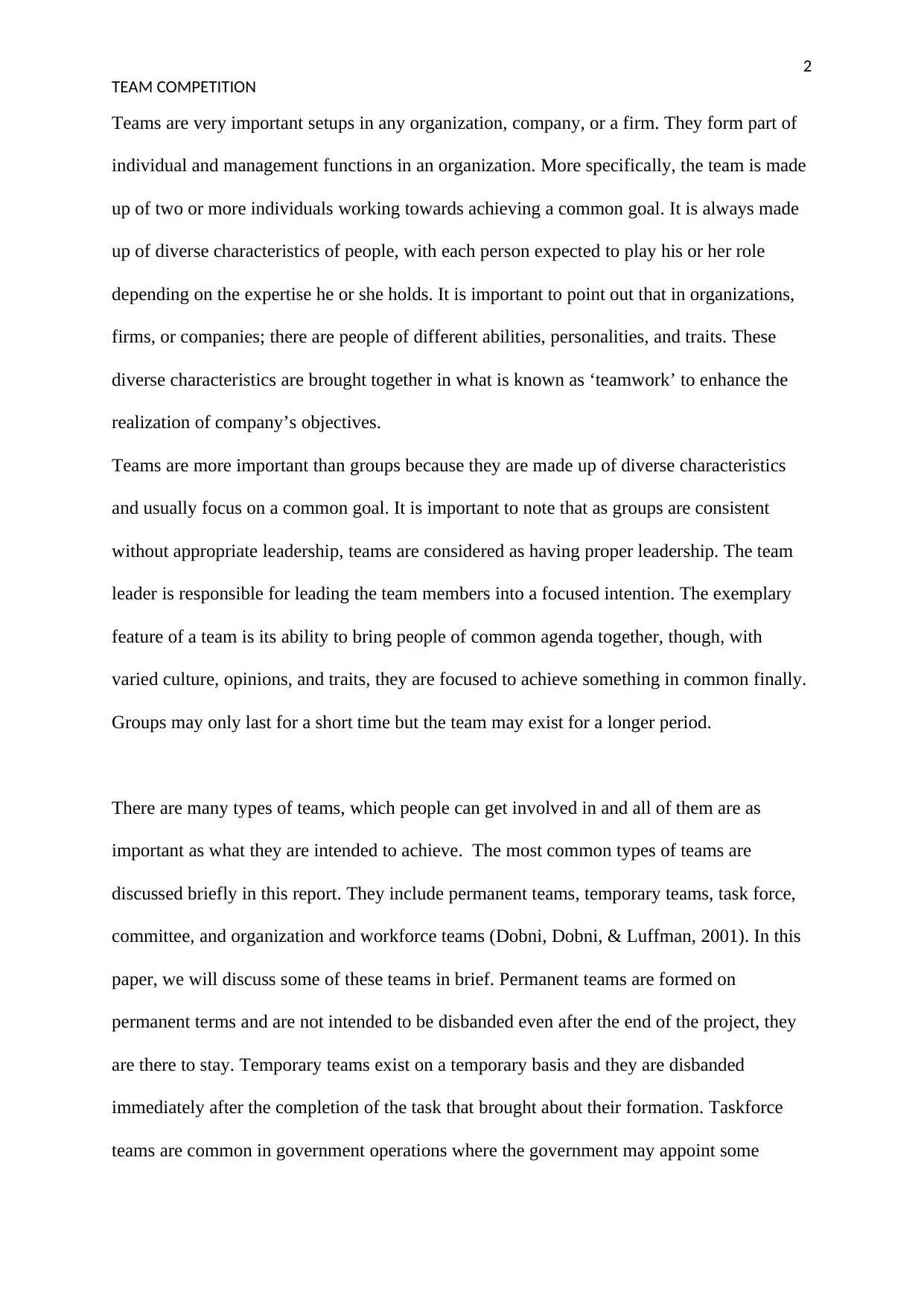
2
TEAM COMPETITION
Teams are very important setups in any organization, company, or a firm. They form part of
individual and management functions in an organization. More specifically, the team is made
up of two or more individuals working towards achieving a common goal. It is always made
up of diverse characteristics of people, with each person expected to play his or her role
depending on the expertise he or she holds. It is important to point out that in organizations,
firms, or companies; there are people of different abilities, personalities, and traits. These
diverse characteristics are brought together in what is known as ‘teamwork’ to enhance the
realization of company’s objectives.
Teams are more important than groups because they are made up of diverse characteristics
and usually focus on a common goal. It is important to note that as groups are consistent
without appropriate leadership, teams are considered as having proper leadership. The team
leader is responsible for leading the team members into a focused intention. The exemplary
feature of a team is its ability to bring people of common agenda together, though, with
varied culture, opinions, and traits, they are focused to achieve something in common finally.
Groups may only last for a short time but the team may exist for a longer period.
There are many types of teams, which people can get involved in and all of them are as
important as what they are intended to achieve. The most common types of teams are
discussed briefly in this report. They include permanent teams, temporary teams, task force,
committee, and organization and workforce teams (Dobni, Dobni, & Luffman, 2001). In this
paper, we will discuss some of these teams in brief. Permanent teams are formed on
permanent terms and are not intended to be disbanded even after the end of the project, they
are there to stay. Temporary teams exist on a temporary basis and they are disbanded
immediately after the completion of the task that brought about their formation. Taskforce
teams are common in government operations where the government may appoint some
TEAM COMPETITION
Teams are very important setups in any organization, company, or a firm. They form part of
individual and management functions in an organization. More specifically, the team is made
up of two or more individuals working towards achieving a common goal. It is always made
up of diverse characteristics of people, with each person expected to play his or her role
depending on the expertise he or she holds. It is important to point out that in organizations,
firms, or companies; there are people of different abilities, personalities, and traits. These
diverse characteristics are brought together in what is known as ‘teamwork’ to enhance the
realization of company’s objectives.
Teams are more important than groups because they are made up of diverse characteristics
and usually focus on a common goal. It is important to note that as groups are consistent
without appropriate leadership, teams are considered as having proper leadership. The team
leader is responsible for leading the team members into a focused intention. The exemplary
feature of a team is its ability to bring people of common agenda together, though, with
varied culture, opinions, and traits, they are focused to achieve something in common finally.
Groups may only last for a short time but the team may exist for a longer period.
There are many types of teams, which people can get involved in and all of them are as
important as what they are intended to achieve. The most common types of teams are
discussed briefly in this report. They include permanent teams, temporary teams, task force,
committee, and organization and workforce teams (Dobni, Dobni, & Luffman, 2001). In this
paper, we will discuss some of these teams in brief. Permanent teams are formed on
permanent terms and are not intended to be disbanded even after the end of the project, they
are there to stay. Temporary teams exist on a temporary basis and they are disbanded
immediately after the completion of the task that brought about their formation. Taskforce
teams are common in government operations where the government may appoint some
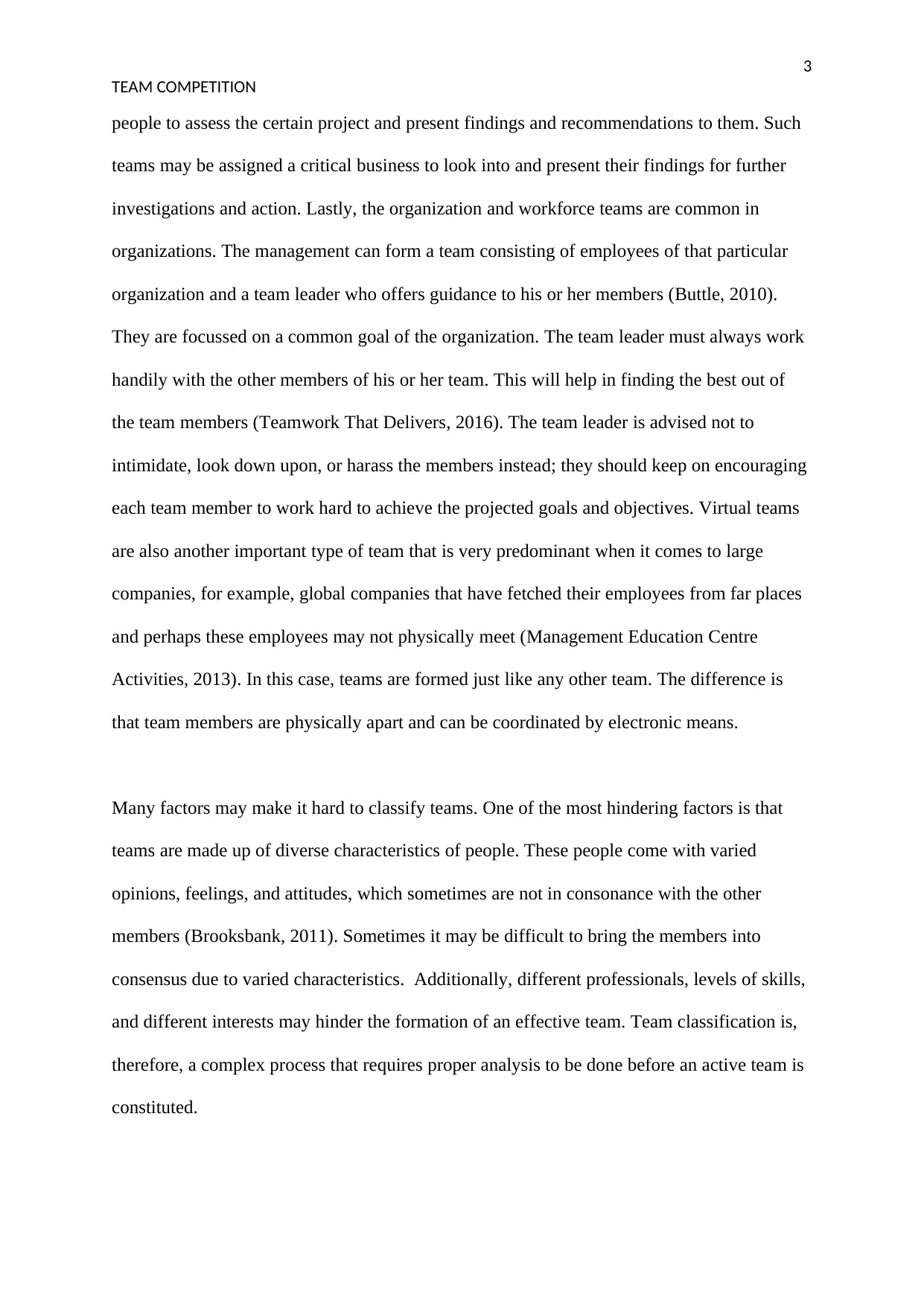
3
TEAM COMPETITION
people to assess the certain project and present findings and recommendations to them. Such
teams may be assigned a critical business to look into and present their findings for further
investigations and action. Lastly, the organization and workforce teams are common in
organizations. The management can form a team consisting of employees of that particular
organization and a team leader who offers guidance to his or her members (Buttle, 2010).
They are focussed on a common goal of the organization. The team leader must always work
handily with the other members of his or her team. This will help in finding the best out of
the team members (Teamwork That Delivers, 2016). The team leader is advised not to
intimidate, look down upon, or harass the members instead; they should keep on encouraging
each team member to work hard to achieve the projected goals and objectives. Virtual teams
are also another important type of team that is very predominant when it comes to large
companies, for example, global companies that have fetched their employees from far places
and perhaps these employees may not physically meet (Management Education Centre
Activities, 2013). In this case, teams are formed just like any other team. The difference is
that team members are physically apart and can be coordinated by electronic means.
Many factors may make it hard to classify teams. One of the most hindering factors is that
teams are made up of diverse characteristics of people. These people come with varied
opinions, feelings, and attitudes, which sometimes are not in consonance with the other
members (Brooksbank, 2011). Sometimes it may be difficult to bring the members into
consensus due to varied characteristics. Additionally, different professionals, levels of skills,
and different interests may hinder the formation of an effective team. Team classification is,
therefore, a complex process that requires proper analysis to be done before an active team is
constituted.
TEAM COMPETITION
people to assess the certain project and present findings and recommendations to them. Such
teams may be assigned a critical business to look into and present their findings for further
investigations and action. Lastly, the organization and workforce teams are common in
organizations. The management can form a team consisting of employees of that particular
organization and a team leader who offers guidance to his or her members (Buttle, 2010).
They are focussed on a common goal of the organization. The team leader must always work
handily with the other members of his or her team. This will help in finding the best out of
the team members (Teamwork That Delivers, 2016). The team leader is advised not to
intimidate, look down upon, or harass the members instead; they should keep on encouraging
each team member to work hard to achieve the projected goals and objectives. Virtual teams
are also another important type of team that is very predominant when it comes to large
companies, for example, global companies that have fetched their employees from far places
and perhaps these employees may not physically meet (Management Education Centre
Activities, 2013). In this case, teams are formed just like any other team. The difference is
that team members are physically apart and can be coordinated by electronic means.
Many factors may make it hard to classify teams. One of the most hindering factors is that
teams are made up of diverse characteristics of people. These people come with varied
opinions, feelings, and attitudes, which sometimes are not in consonance with the other
members (Brooksbank, 2011). Sometimes it may be difficult to bring the members into
consensus due to varied characteristics. Additionally, different professionals, levels of skills,
and different interests may hinder the formation of an effective team. Team classification is,
therefore, a complex process that requires proper analysis to be done before an active team is
constituted.
⊘ This is a preview!⊘
Do you want full access?
Subscribe today to unlock all pages.

Trusted by 1+ million students worldwide
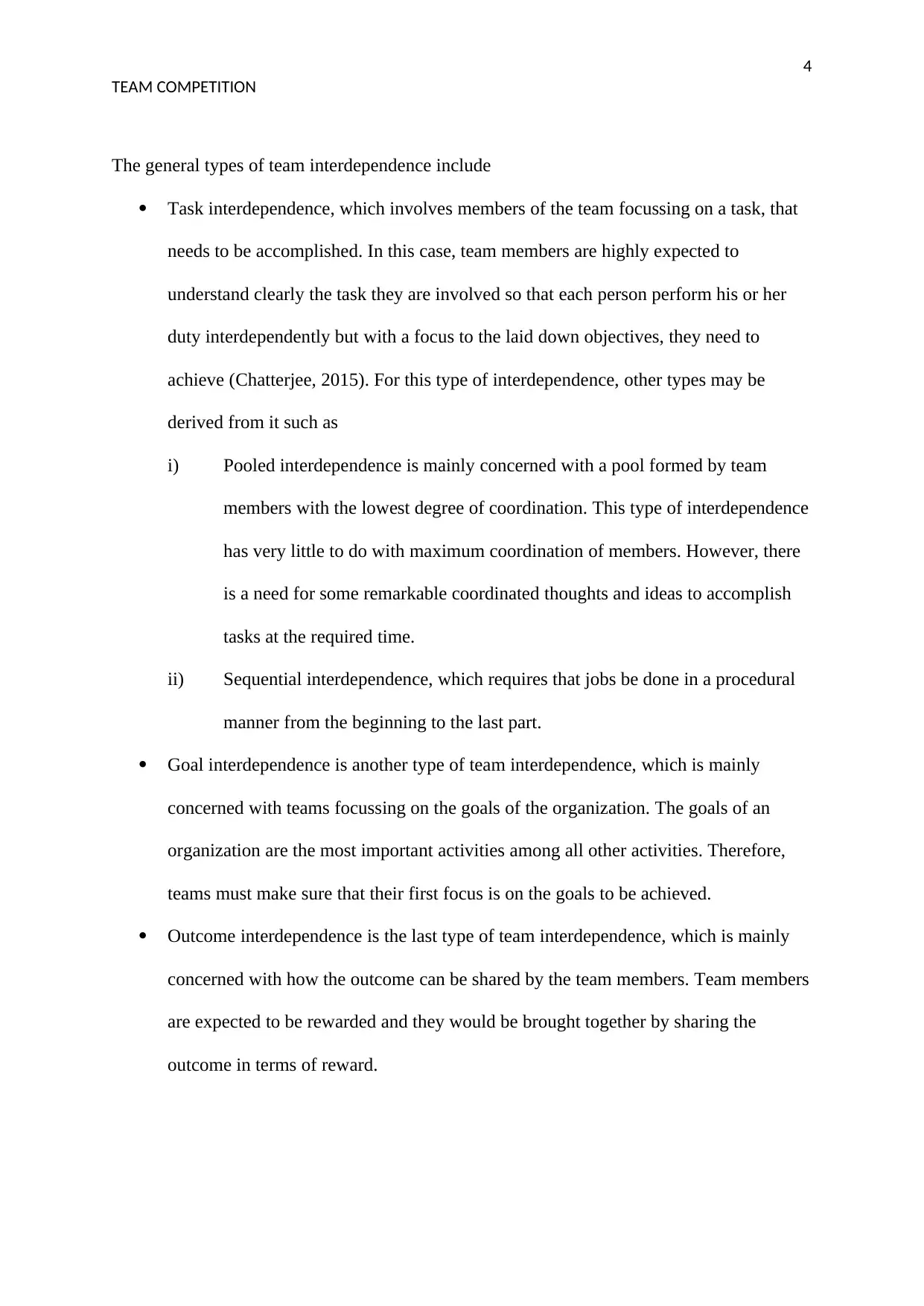
4
TEAM COMPETITION
The general types of team interdependence include
Task interdependence, which involves members of the team focussing on a task, that
needs to be accomplished. In this case, team members are highly expected to
understand clearly the task they are involved so that each person perform his or her
duty interdependently but with a focus to the laid down objectives, they need to
achieve (Chatterjee, 2015). For this type of interdependence, other types may be
derived from it such as
i) Pooled interdependence is mainly concerned with a pool formed by team
members with the lowest degree of coordination. This type of interdependence
has very little to do with maximum coordination of members. However, there
is a need for some remarkable coordinated thoughts and ideas to accomplish
tasks at the required time.
ii) Sequential interdependence, which requires that jobs be done in a procedural
manner from the beginning to the last part.
Goal interdependence is another type of team interdependence, which is mainly
concerned with teams focussing on the goals of the organization. The goals of an
organization are the most important activities among all other activities. Therefore,
teams must make sure that their first focus is on the goals to be achieved.
Outcome interdependence is the last type of team interdependence, which is mainly
concerned with how the outcome can be shared by the team members. Team members
are expected to be rewarded and they would be brought together by sharing the
outcome in terms of reward.
TEAM COMPETITION
The general types of team interdependence include
Task interdependence, which involves members of the team focussing on a task, that
needs to be accomplished. In this case, team members are highly expected to
understand clearly the task they are involved so that each person perform his or her
duty interdependently but with a focus to the laid down objectives, they need to
achieve (Chatterjee, 2015). For this type of interdependence, other types may be
derived from it such as
i) Pooled interdependence is mainly concerned with a pool formed by team
members with the lowest degree of coordination. This type of interdependence
has very little to do with maximum coordination of members. However, there
is a need for some remarkable coordinated thoughts and ideas to accomplish
tasks at the required time.
ii) Sequential interdependence, which requires that jobs be done in a procedural
manner from the beginning to the last part.
Goal interdependence is another type of team interdependence, which is mainly
concerned with teams focussing on the goals of the organization. The goals of an
organization are the most important activities among all other activities. Therefore,
teams must make sure that their first focus is on the goals to be achieved.
Outcome interdependence is the last type of team interdependence, which is mainly
concerned with how the outcome can be shared by the team members. Team members
are expected to be rewarded and they would be brought together by sharing the
outcome in terms of reward.
Paraphrase This Document
Need a fresh take? Get an instant paraphrase of this document with our AI Paraphraser
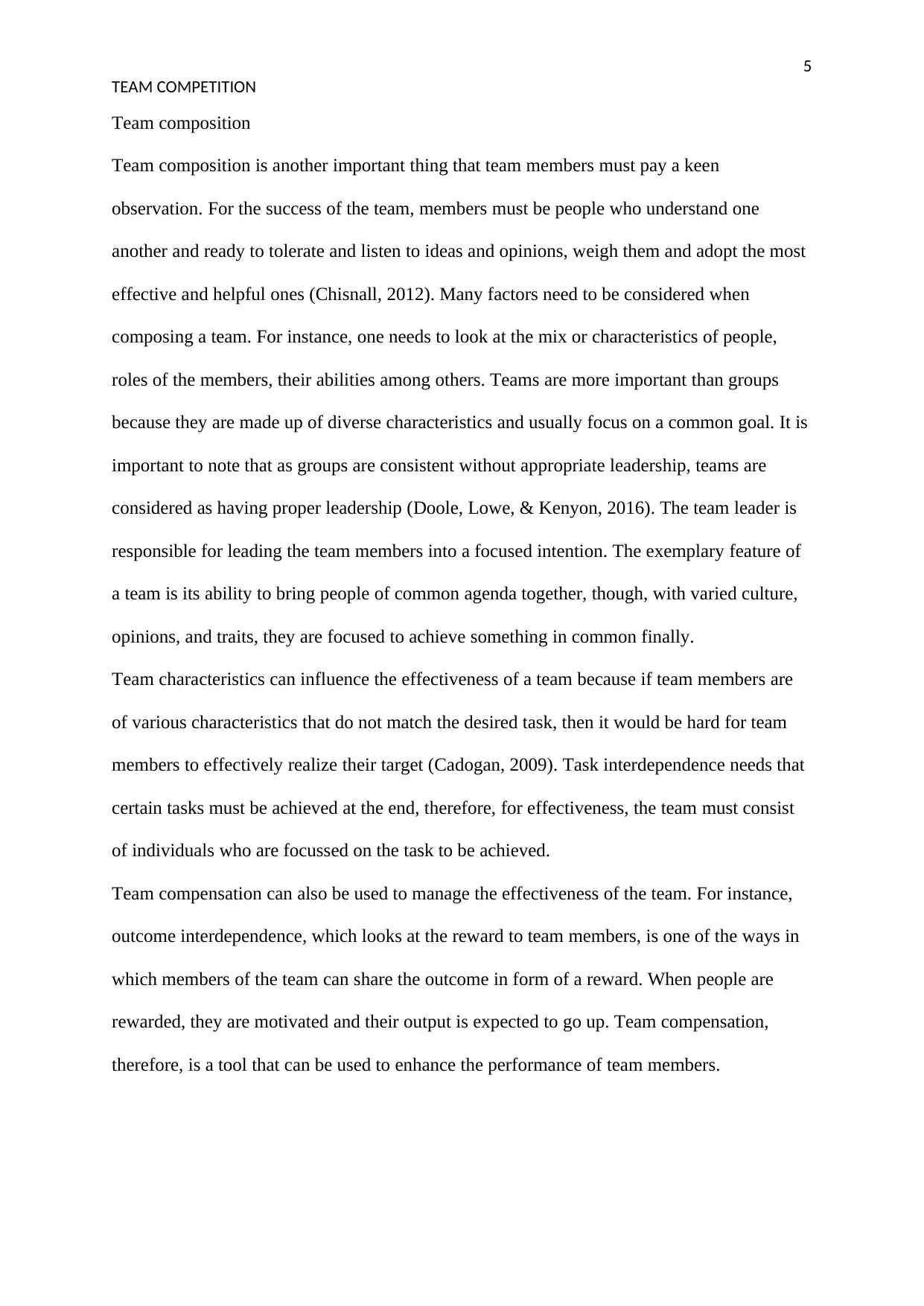
5
TEAM COMPETITION
Team composition
Team composition is another important thing that team members must pay a keen
observation. For the success of the team, members must be people who understand one
another and ready to tolerate and listen to ideas and opinions, weigh them and adopt the most
effective and helpful ones (Chisnall, 2012). Many factors need to be considered when
composing a team. For instance, one needs to look at the mix or characteristics of people,
roles of the members, their abilities among others. Teams are more important than groups
because they are made up of diverse characteristics and usually focus on a common goal. It is
important to note that as groups are consistent without appropriate leadership, teams are
considered as having proper leadership (Doole, Lowe, & Kenyon, 2016). The team leader is
responsible for leading the team members into a focused intention. The exemplary feature of
a team is its ability to bring people of common agenda together, though, with varied culture,
opinions, and traits, they are focused to achieve something in common finally.
Team characteristics can influence the effectiveness of a team because if team members are
of various characteristics that do not match the desired task, then it would be hard for team
members to effectively realize their target (Cadogan, 2009). Task interdependence needs that
certain tasks must be achieved at the end, therefore, for effectiveness, the team must consist
of individuals who are focussed on the task to be achieved.
Team compensation can also be used to manage the effectiveness of the team. For instance,
outcome interdependence, which looks at the reward to team members, is one of the ways in
which members of the team can share the outcome in form of a reward. When people are
rewarded, they are motivated and their output is expected to go up. Team compensation,
therefore, is a tool that can be used to enhance the performance of team members.
TEAM COMPETITION
Team composition
Team composition is another important thing that team members must pay a keen
observation. For the success of the team, members must be people who understand one
another and ready to tolerate and listen to ideas and opinions, weigh them and adopt the most
effective and helpful ones (Chisnall, 2012). Many factors need to be considered when
composing a team. For instance, one needs to look at the mix or characteristics of people,
roles of the members, their abilities among others. Teams are more important than groups
because they are made up of diverse characteristics and usually focus on a common goal. It is
important to note that as groups are consistent without appropriate leadership, teams are
considered as having proper leadership (Doole, Lowe, & Kenyon, 2016). The team leader is
responsible for leading the team members into a focused intention. The exemplary feature of
a team is its ability to bring people of common agenda together, though, with varied culture,
opinions, and traits, they are focused to achieve something in common finally.
Team characteristics can influence the effectiveness of a team because if team members are
of various characteristics that do not match the desired task, then it would be hard for team
members to effectively realize their target (Cadogan, 2009). Task interdependence needs that
certain tasks must be achieved at the end, therefore, for effectiveness, the team must consist
of individuals who are focussed on the task to be achieved.
Team compensation can also be used to manage the effectiveness of the team. For instance,
outcome interdependence, which looks at the reward to team members, is one of the ways in
which members of the team can share the outcome in form of a reward. When people are
rewarded, they are motivated and their output is expected to go up. Team compensation,
therefore, is a tool that can be used to enhance the performance of team members.
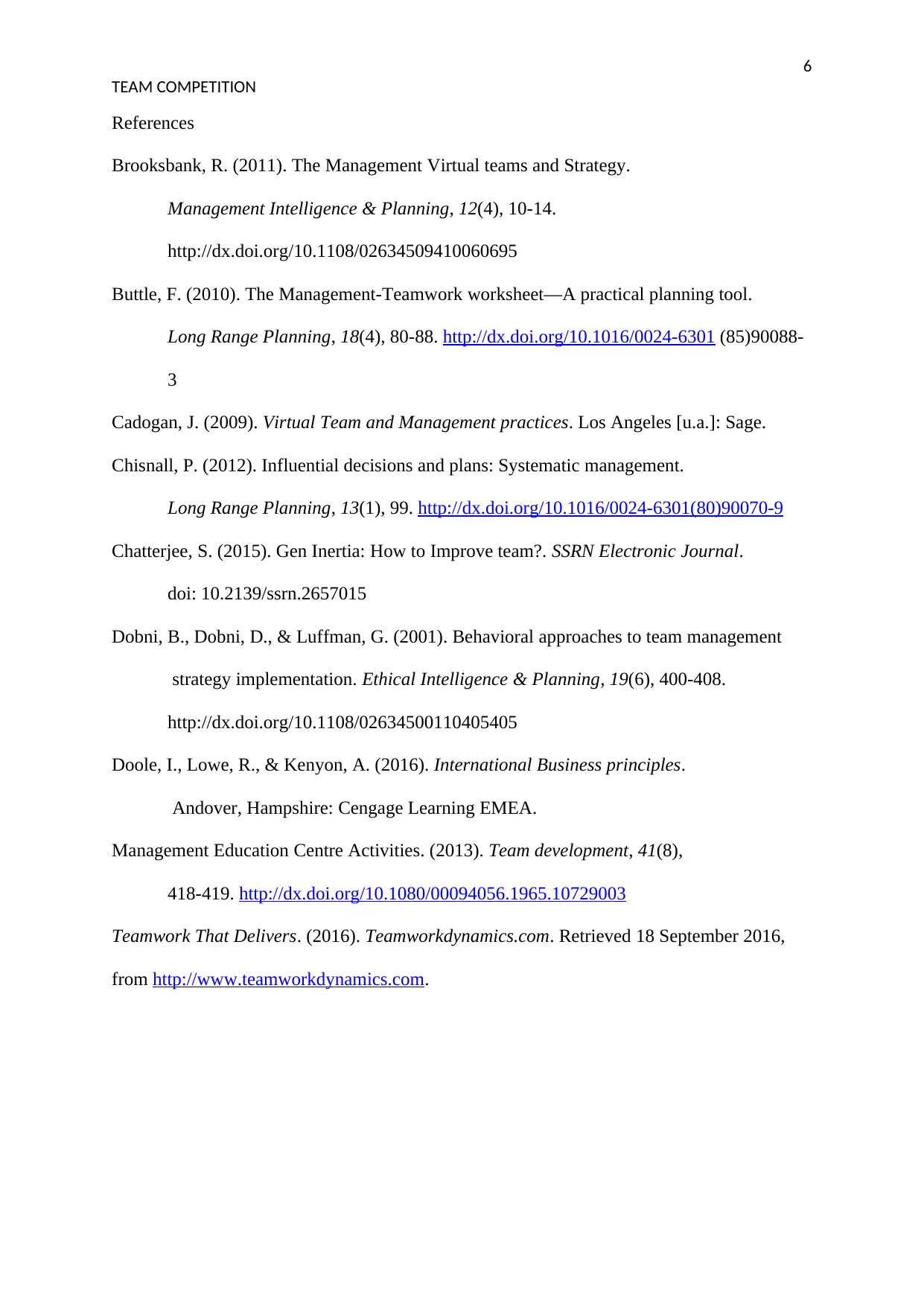
6
TEAM COMPETITION
References
Brooksbank, R. (2011). The Management Virtual teams and Strategy.
Management Intelligence & Planning, 12(4), 10-14.
http://dx.doi.org/10.1108/02634509410060695
Buttle, F. (2010). The Management-Teamwork worksheet—A practical planning tool.
Long Range Planning, 18(4), 80-88. http://dx.doi.org/10.1016/0024-6301 (85)90088-
3
Cadogan, J. (2009). Virtual Team and Management practices. Los Angeles [u.a.]: Sage.
Chisnall, P. (2012). Influential decisions and plans: Systematic management.
Long Range Planning, 13(1), 99. http://dx.doi.org/10.1016/0024-6301(80)90070-9
Chatterjee, S. (2015). Gen Inertia: How to Improve team?. SSRN Electronic Journal.
doi: 10.2139/ssrn.2657015
Dobni, B., Dobni, D., & Luffman, G. (2001). Behavioral approaches to team management
strategy implementation. Ethical Intelligence & Planning, 19(6), 400-408.
http://dx.doi.org/10.1108/02634500110405405
Doole, I., Lowe, R., & Kenyon, A. (2016). International Business principles.
Andover, Hampshire: Cengage Learning EMEA.
Management Education Centre Activities. (2013). Team development, 41(8),
418-419. http://dx.doi.org/10.1080/00094056.1965.10729003
Teamwork That Delivers. (2016). Teamworkdynamics.com. Retrieved 18 September 2016,
from http://www.teamworkdynamics.com.
TEAM COMPETITION
References
Brooksbank, R. (2011). The Management Virtual teams and Strategy.
Management Intelligence & Planning, 12(4), 10-14.
http://dx.doi.org/10.1108/02634509410060695
Buttle, F. (2010). The Management-Teamwork worksheet—A practical planning tool.
Long Range Planning, 18(4), 80-88. http://dx.doi.org/10.1016/0024-6301 (85)90088-
3
Cadogan, J. (2009). Virtual Team and Management practices. Los Angeles [u.a.]: Sage.
Chisnall, P. (2012). Influential decisions and plans: Systematic management.
Long Range Planning, 13(1), 99. http://dx.doi.org/10.1016/0024-6301(80)90070-9
Chatterjee, S. (2015). Gen Inertia: How to Improve team?. SSRN Electronic Journal.
doi: 10.2139/ssrn.2657015
Dobni, B., Dobni, D., & Luffman, G. (2001). Behavioral approaches to team management
strategy implementation. Ethical Intelligence & Planning, 19(6), 400-408.
http://dx.doi.org/10.1108/02634500110405405
Doole, I., Lowe, R., & Kenyon, A. (2016). International Business principles.
Andover, Hampshire: Cengage Learning EMEA.
Management Education Centre Activities. (2013). Team development, 41(8),
418-419. http://dx.doi.org/10.1080/00094056.1965.10729003
Teamwork That Delivers. (2016). Teamworkdynamics.com. Retrieved 18 September 2016,
from http://www.teamworkdynamics.com.
⊘ This is a preview!⊘
Do you want full access?
Subscribe today to unlock all pages.

Trusted by 1+ million students worldwide
1 out of 6
Related Documents
Your All-in-One AI-Powered Toolkit for Academic Success.
+13062052269
info@desklib.com
Available 24*7 on WhatsApp / Email
![[object Object]](/_next/static/media/star-bottom.7253800d.svg)
Unlock your academic potential
Copyright © 2020–2025 A2Z Services. All Rights Reserved. Developed and managed by ZUCOL.





